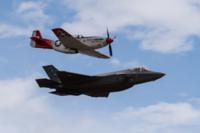The dedication of a first-of-its kind national memorial to veterans of the First Gulf War Tuesday in Washington, D.C. drew dignitaries including former Vice President Dick Cheney, who oversaw Operations Desert Storm and Desert Shield in his role as defense secretary.
In his remarks at the ceremony, Cheney, 78, said the site on the National Mall, off Constitution Avenue and by the Vietnam Veterans Memorial, is a fitting tribute to veterans of the war, who were "welcomed home with the gratitude and respect they earned," in contrast to Vietnam veterans.
Veterans of the first Gulf War who spoke at the ceremony also said that the lessons of Vietnam were on their minds as Operation Desert Shield began in early August 1990 to protect Saudi Arabia from Iraqi invasion and begin the assembly of a coalition force of more than 600,000 for the liberation of Kuwait.
Operation Desert Storm began in January 1991 with ferocious air and naval bombardments that lasted five weeks and cleared the way for the ground campaign that drove the Iraqis from Kuwait in 100 hours, culminating in a cease-fire on Feb. 28, 1991.
"The dire predictions of thousands of casualties never came to pass, with the ensuing rapid and resounding victory putting to rest the doubts about our all-volunteer force," Scott Stump, a Marine veteran of Desert Storm/Desert Shield and president of the National Desert Storm War Memorial Association, said.
The Pentagon lists 383 U.S. troops as having been killed in action in Desert Shield/Desert Storm.
Related content:
- 6 Things to Know About Operation Desert Storm
- Who Counts as a 'Gulf War Veteran'?
- 21 Facts About the First Gulf War
Stump said the concept for a memorial on or near the National Mall began to take shape in 2010. President Barack Obama authorized construction in 2014; President Donald Trump approved construction near the Mall in 2017.
One of the sites originally suggested was along the Potomac River, but the U.S. Commission of Fine Arts, the National Capital Planning Commission and the National Park Service in June 2018 finally approved the site off Constitution Avenue, just across 23rd Street NW from the Vietnam Veterans Memorial and down the rise to the Lincoln Memorial.
No date has been set for a groundbreaking ceremony, but Stump said the grand opening for the memorial is planned for Veterans Day 2021.
The task now is to raise the estimated $40 million for construction of the memorial. The association has about $8 million already donated, he said.
In his remarks at the dedication ceremony, retired Air Force Gen. Chuck Horner, a Vietnam veteran and architect of the Desert Storm air campaign, several times gestured over his shoulder to the Vietnam Veterans Memorial to make his point that Vietnam and Desert Storm were "inextricably linked" in the different ways they were fought.
The senior leadership in Desert Storm "gave the military a mission" and "didn't impose rules of engagement on us. So we were blessed" and able "to avoid the stupidness that led to that disaster over there," he said, gesturing again to the Vietnam Veterans Memorial.
"We fought it with our hands untied," Horner said, adding he was "glad we had the leadership that decided victory was the answer and allowed us to do it."
Cheney, who became a lightning rod for critics of the 2003 Iraq invasion and occupation when he served as vice president, said the conflict that liberated Kuwait in 1991 restored the nation's pride and confidence in its military, which had been shaken by Vietnam and its aftermath.
Based on the "crucial lessons learned in Southeast Asia," he said that he and then-President George H.W. Bush prepared for swift victory and had an exit strategy in mind in rallying a coalition to repel the invasion of Kuwait by Iraqi dictator Saddam Hussein.
"For all the risk involved," the mission was vital, Cheney said. "We had to show him that the world doesn't work that way anymore, and we did."
Cheney said that he and his wife, Lynne, visited the Vietnam Veterans Memorial on Jan. 16, 1991, the night before the air campaign in Desert Storm began, to sense the responsibility that the senior leadership was about to undertake from the more than 58,000 names of the fallen listed on the memorial's iconic Wall.
"We knew, of course, that some of them would not return," he said of those who would go into battle in Desert Storm. "We wanted to make sure we got it right this time."
Other Desert Storm veterans who attended the ceremony had their own takes on the lessons learned from Vietnam.
Wayne Gunther, 54, of Strum, Wisconsin, who retired as a warrant officer but was a sergeant with Golf Co., 2nd Battalion, Third Marines, during Desert Storm, said of Vietnam veterans that "those were the guys that taught us" how to fight.
Gunther said he was assigned to clear paths through the Iraqi minefields for tanks and mechanized infantry and eventually reached Kuwait City in the offensive.
"It was staggering, it was so quick," he said.
He had heard all the scuttlebutt that "it was gonna be awful, we were gonna go through a meat grinder." He said it probably "would have been a slugfest without the air campaign," but "it never came to that ugliness."
Former Air Force Master Sgt. Jim Ayres, who serviced refueling tankers with the 1709 Provisional Air Wing, said it was "the greatest honor ever" to have the Desert Shield/Desert Storm Memorial in proximity to the Vietnam Veterans Memorial, the Korean War Veterans Memorial and the World War II Memorial.
Retired Army Lt. Col. Kyle Leggs, 54, of Baltimore, a board member of the National Desert Storm War Memorial Association, served with the 200th Movement Control Team.
"It was intense to be in a war not knowing what to expect," he said, including the possible use by the Iraqis of chemical and biological weapons. He was in Dhahran, Saudi Arabia, when it was hit by an Iraqi Scud missile that killed 28 U.S. troops. He said the memorial is partly "about those who didn't come home."
However, Leggs echoed other board members in stating that the memorial, when it is complete, "should not be about mourning," but more of a place "to appreciate a U.S.-led victory" that was a "turning point in our military history."
-- Richard Sisk can be reached at Richard.Sisk@Military.com.















